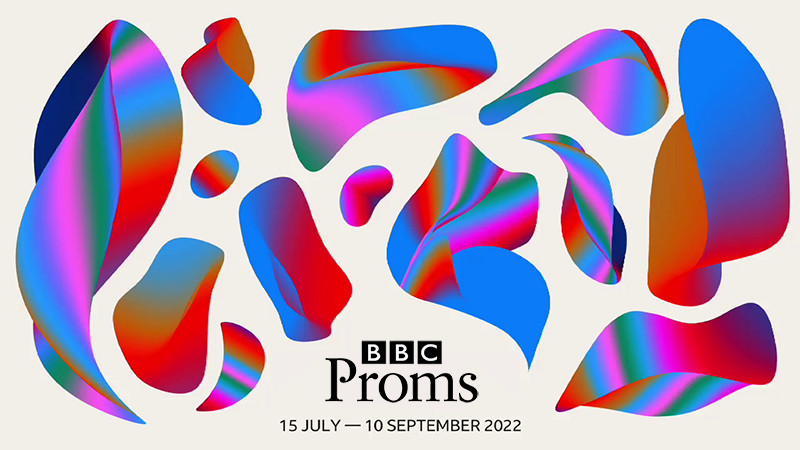
Finally. Following six premières of, to say the least, wildly varying quality, this year’s Proms season finally struck gold on Monday evening in the form of Gavin Higgins‘ new large-scale work for brass band and orchestra, Concerto Grosso. First things first: it’s a bit of an odd title, as the way Higgins utilises the brass band isn’t really characterised by dialogue with the orchestra at all Rather, the two function as something like parallel entities, albeit in clear sympathy with one another. If anything, each time i’ve listened to Concerto Grosso i’ve thought of it more as a symphony; it certainly evokes the scale and scope of another marvellous work for brass band, John Pickard’s Gaia Symphony, and to my mind makes more sense from that kind of perspective. But what’s in a name?
Regardless what it’s called, Higgins’ self-described “love letter” to the world of the brass band is a remarkable accomplishment, far and away his most impressive work that i’ve heard to date. The piece is structured in two large parts: the first subdivided into three sections, ‘Island’, ‘Coal’ and ‘Class’, the second into two sections, ‘Sentimental Music’ and ‘Contest Music’. Given Higgins’ long-established insatiable desire to start a ruckus, it’s no surprise that Concerto Grosso features its fair share of mayhem. This occurs, as one might expect, in the latter stages of each part of the work and, as tends to be the case in Higgins’ output, what they gain with regard to short-term punch, they lose in terms of originality and memorability.
‘Coal’ invokes the world of coal mines, the piece introducing for the first time chugging motoric rhythms that end up driving ever more forward. Laden with loud clanks and a variety of florid asides, its boisterous but anonymous, the music less about the actual notes being played (which could pretty much be anything) than the way they’re being played. It passes through the periphery of Faberian territory, though in general avoids cliché in favour of some unexpected twists, including a delicious one where everything is pulled back to soft wind undulations and twitches, with unsettling deep bass notes growling far below. ‘Class’ takes the feistiness further, though makes things interesting by throwing together fast and slow ideas simultaneously, bringing back the chugging from ‘Coal’ before making everything sound deeply sinister, registrally polarised, reduced to high wind spasms and low ominous pedal notes.
Its counterpart in Part 2 is ‘Contest Music’, which in some respects contains the most anonymous, superficial material in the whole piece. It’s fun enough, Higgins getting it going as if the brass band were warming up with exercises of arpeggios, runs and accelerandos, but its clear intention is simply to attain the speed and subtlety of a runaway train. In that respect it succeeds – except for its unconvincing, seemingly bolted-on final chord – and from a listening perspective there’s not much to do besides hang on for dear life.

But if these sequences seem in hindsight rather generic and forgettable, that’s only because the rest of the work – by far the majority of it, in terms of both substance and duration – is so utterly memorable. This is Higgins at his most intimate, intense and expressively authentic. Part 1 begins with an 8-minute ‘Island’, perhaps a homage to this land, that takes its time moving through lengthy melodic strands that move between mystery, wistfulness, melancholy and love. Though not conventionally tonal, its obliquely consonant language is occasionally glanced by the scrunch of dissonance, though an early instance fades gently, while later the impacts are made into something majestic. The tenderness of this section is extremely potent: soft individual lines winding around each other, picking up where the previous voice left off, articulating a single, united train of thought. It’s made all the more powerful by the way Higgins ebbs and flows between tangibility and remoteness, putting the music at a distance, at times making it so faint it becomes a far-off nebulous blur.
The counterpart to this in Part 2 is ‘Sentimental Music’, an even more lengthy slab of the most heartfelt evocation. The title perhaps does Higgins something of a disservice, as the music – thank goodness – isn’t conventionally sentimental at all, being neither mawkish nor saccharine in the slightest. What it is is an even more careful and considered act of musical searching. Where ‘Island’ was drawn-out but focused, here the outlook is more instinctual, somewhat feeling its way forward gingerly, along the way moving back and forth between band and orchestra, the latter continually supporting, reinforcing, and occasionally extending, the band’s ideas. There’s a vulnerability to this music, a fragility even, that makes it not only stunningly beautiful but very deeply immersive. It’s here that Higgins’ music is most obviously a “love letter”, one that glances back while resolutely looking and moving forward. The small-scale climaxes that occur are like shudders of absolute pleasure, brief moments of ecstasy that testify to the potency of feeling running throughout not just this remarkable section, but the work as a whole. Absolutely outstanding.
The world première of Concerto Grosso was given by the Tredegar Band and BBC National Orchestra of Wales conducted by Ryan Bancroft.
HAVE YOUR SAY
Gavin Higgins - Concerto Grosso
- Loved it! (39%, 15 Votes)
- Liked it (26%, 10 Votes)
- Meh (21%, 8 Votes)
- Disliked it (8%, 3 Votes)
- Hated it! (5%, 2 Votes)
Total Voters: 38
Programme note
For some, the British brass band may inspire images of days gone by – of miners and “the Hovis advert’, or Terry Wogan and the Floral Dance. But brass bands are a living, vital, and integral part of our musical cultural whose reach extends far beyond the borders of this little island.
The British brass band movement is unique within the musical world, both in terms of its geographical roots – originating in the coalfields of the North, Wales and Scotland – but also, for much of its history, being a distinctly working-class pursuit. The early popularity of brass bands resulted in a rapid proliferation of bands throughout the UK to the point that they could be found in almost every village and town in the country, with close connections to the local pits, collieries, and factories. As such, brass bands, ‘could be regarded as one of the most important aspects of British art music,’ their growth resulting in, ‘the first mass involvement of working-class people in instrumental art music, not just in Britain, but possibly anywhere.’ (Trevor Herbert, ‘Bands: The Brass Band Movement in the 19th and 20th Centuries’).
This is a music born of industry – from coal and steel and tin – the sound of the brass band, for me, inexorably bound up with the bleak mining landscapes of Britain. But it is also intrinsically linked to politics. When Thatcher went head-to-head with the National Union of Mine Workers in 1984, in what was to be the longest and most bitter industrial dispute in British history, brass bands became a symbol of resistance, With pits under threat, so were the bands associated with them, many being forced to fight for their very existence. Despite the rapid dismantling of British industries over the past three decades, brass bands continue to thrive both in UK and internationally. This is a testament to the enduring appeal of a music which is so evocative, so redolent of a time and place that it sits at the very heart of the British musical and cultural landscape; and yet there is a universality to this music that now extends beyond borders, class, and politics. Brass bands may have
originated in the coalfields of Britain, but there are flourishing brass band scenes now in every corner of the world.
Having grown up in an ex-mining community – beginning my musical training in the local brass bands in which my whole family continue to play – this music is close to my heart. Concerto Grosso for Brass Band and Orchestra is a love letter to that music and those communities. Drawing on banding’s cultural legacy and musical style it is a celebratory work that puts the brass band front and centre. Concerto Grosso for Brass Band and Orchestra is a five movement piece in two parts. Part one looks at the mediums geographical, industrial, and socio-economic roots; whilst Part two explores musical aspects synonymous with the music: high lyricism and dazzling virtuosity.

This certainly sounds way more interesting than the previous premieres, even though the piece is long.
The program notes mention Wogan, but the instrumental version of The Floral Dance (the Brighouse and Rastrick Brass Band) was released earlier and was a huge hit.